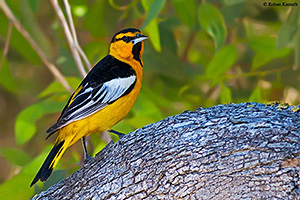 |
Bullock's Oriole
Icterus bullockii |
|
|
STANFORD LOCATIONS: Uncommon migrant and summer resident virtually throughout campus, more widespread than the Hooded Oriole. Often seen in oaks and eucalyptus in the Arboretum and in woodlands near the Dish |
 |
Location |
Type |
Mating System |
Parental Care |
2ndary Diet |
Strategy |
|
|
|
|
I: 12-14 DAYS ALTRICIAL |
|
|
|
(6 feet - 60 feet) |
|
(3-6) MONOG? |
MF |
NECTAR |
|
| BREEDING: | Open and riparian woodland, decid forest edge, open areas with scattered trees, around human habitation. 1 brood. |
| DISPLAYS: | Courting male rises to full height, bows low to female with tail spread and wings slightly raised; alternates between these two postures. |
| NEST: | Rarely in conif tree, attached at rim or secured at sides to drooping branch; woven of plant fiber strips, lined with fine grass, plant down, hair. Built in 4.5-15 days. |
| EGGS: | Pale grayish- to bluish-white, marked with dark colors. 0.9" (23 mm). |
| DIET: | Includes few spiders, snails; some buds in spring. |
| CONSERVATION: | Winters from c Mexico s to n e S.A., Greater Antilles; increasingly remains in e U.S. and CA due to feeders. Uncommon cowbird host; may elect cowbird eggs. |
| NOTES: | Formerly called Northern Oriole, now considered as two species, Baltimore and Bullock's Orioles. Loosely colonial in riparian woodland as a consequence of nest site scarcity. Female (Bullock's) sings early in nesting season. Males sexually mature at 1 year but acquire adult plumage in year 2. Postbreeding flocks of juveniles and females; adult males solitary. Solitary to slightly gregarious in winter in groups of up to 4. |
| ESSAYS: | Great Plains Hybrids; Decline of Eastern Songbirds; Feeding Birds; Taxonomy and Nomenclature. |
| REFERENCES: | Flood, 1984; Pleasants, 1979; Sealy, 1980. |
| Help | Abbreviations | Species-Alphabetical | Species-Taxonomic | Essays-Alphabetical | |
| Except for Stanford Locations, the material in this species treatment is taken, with permission, from The Birder's Handbook (Paul Ehrlich, David Dobkin, & Darryl Wheye, Simon & Schuster, NY. 1988). | |||||